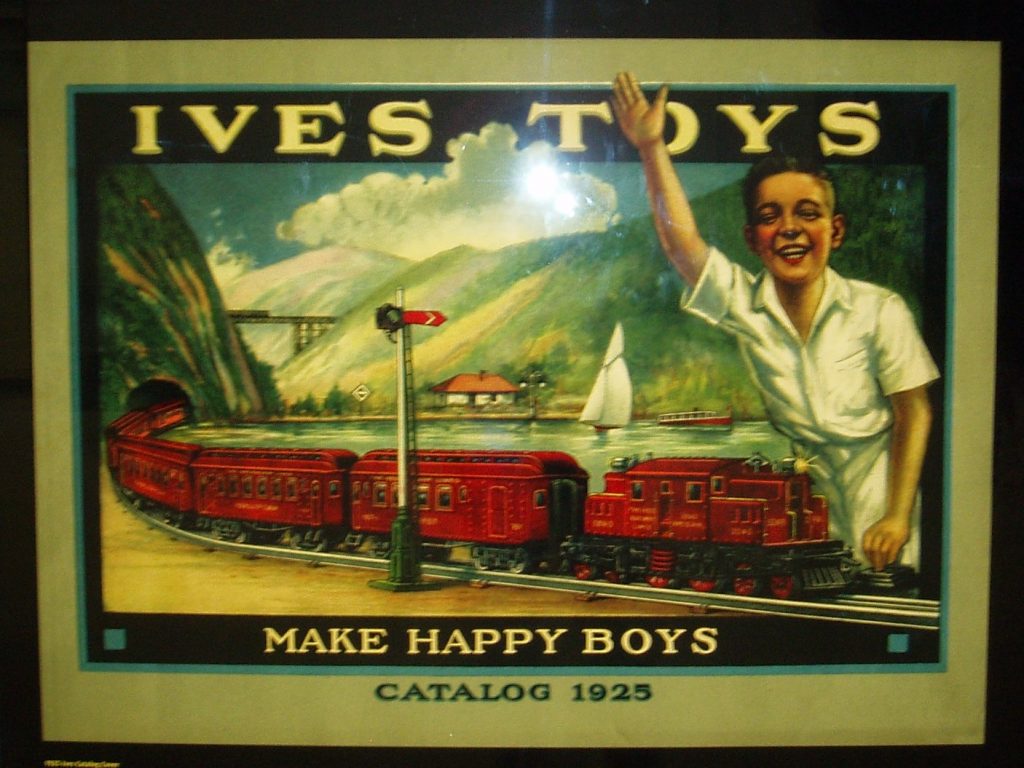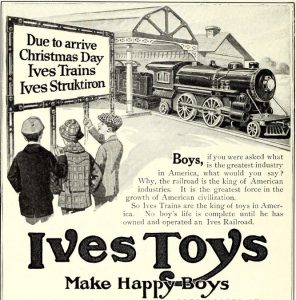By Edward T. Howe
The Ives Manufacturing Company of Bridgeport—arguably Connecticut’s most famous toy company and one of the largest in the United States—began operations in 1868. In the ensuing decades, it became known for its variety of clockwork toys and trains. Despite the company’s successful introduction of electric trains in 1910, emerging financial and competitive challenges eroded its leading market position in the 1920s. These pressures eventually resulted in bankruptcy and sale of the company in 1928.
The Start of Toy Manufacturing

Walking horse, Ives Toys manufacturer, ca. 1868, New York Historical Society – Wikipedia Loves Art project, Wikimedia Commons
Up until the early 19th century, the majority of toys for children were homemade. In 1838, Francis, Field and Francis of Philadelphia became the first known company to make a manufactured toy in the United States—a tin horse-drawn fire engine. In Connecticut, the manufacture of toys started in 1856 when George W. Brown of Forestville made tin pull and clockwork toys, including a train. J. and E. Stevens Company—formed in 1843 in Cromwell—initially made harness and cast-iron hardware but became the first maker of cast-iron toys. Their new venture was so popular that, after 1859, the firm primarily produced toys—especially cap pistols and mechanical banks. Between 1854 and 1886, other smaller toy companies emerged, including Merriam Manufacturing Company (Durham), Union Manufacturing Company (Clinton), and Hull and Stafford Company (Clinton).
Ives Enters the Toy Market
Edward B. Ives (1839-1918) began making hot air toys (such as paper dolls with moving limbs) in Plymouth in 1868 before moving to Bridgeport in 1870. After the move, his company focused mainly on tin clockwork toys, selling to toy jobbers (wholesalers) in New York City and elsewhere. The growing array of clockwork and hot air toys, games, and other items developed for the firm increasingly dominated the toy market in the early 1870s. In 1874, Ives invented the first tin trackless locomotives with a whistle—heralding a future emphasis on electric trains. Notably, the toys were so popular that the 1876 Centennial Exhibition in Philadelphia selected several of them for display. By the 1880s, Ives’ company had become one of the leaders in the toy industry through catalogs aimed at wholesalers, exports to Europe and South America, and the sale of products made by other firms. In the 1890s, his firm mainly concentrated on iron toys (e.g., locomotives, fire engines, and cannons) that became increasingly detailed.
“Ives Toys Make Happy Boys”
In 1897, the company—now known as Ives & Williams—entered receivership. Subdued economic conditions stemming from the Panic of 1893 had left it with insufficient revenue to pay its suppliers. Another setback occurred on December 22, 1900, when a large fire destroyed its ability to make cast-iron toys. A year later, however, Edward Ives and his son Harry formed the Ives Manufacturing Company (incorporated in 1902). The new firm focused on O gauge clockwork “trains on tracks,” which quickly became its mainstay, along with improved models of earlier toys.
In 1910, the company began making cast-iron electric trains in both O gauge and 1 gauge as competition from the American Flyer Company and the American Miniature Railway Company in Bridgeport threatened its clockwork trains. Ives successfully marketed these electric trains through its advertising slogan, “Ives Toys Make Happy Boys.” An electric current supplied by batteries or a transformer powered these reality-resembling trains that required relatively expensive quality materials. Complementary accessories (e.g., stations, signals, tunnels and bridges) further enhanced train sales.
Toys and Troubles
Unfortunately, financial and competitive pressures seriously hurt the company in the 1920s. The financial problems involved a continuing failure of revenues to cover the costs of production, free service repairs, and problems with poorly designed toy boats. The Lionel Corporation, its main competitor, fought Ives through lawsuits and expensive advertising efforts. Lionel not only enticed children to buy its trains at comparable or lower prices, but also denigrated the quality of Ives’ trains. As these financial and competitive pressures mounted in the mid-1920s, the money-losing Ives Manufacturing Company finally filed for bankruptcy in 1928. Lionel and American Flyer purchased the company that same year, ending its run as a major independent toy producer.
Edward T. Howe, Ph.D., is Professor of Economics, Emeritus, at Siena College near Albany, N.Y.










